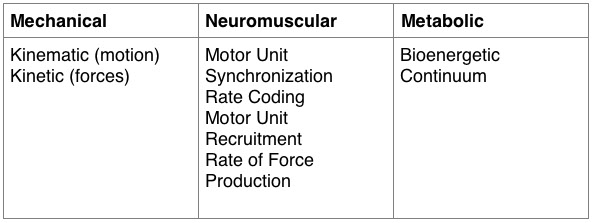The Principle of Specificity is often referred to as the SAID Principle, which stands for Specific Adaptation to Imposed Demands.
The kinetic chain will specifically adapt to the type of demand placed upon it.
For example, if someone repeatedly lifts heavy weights with minimal repetitions and maximal rest periods that person will produce higher levels of maximal strength and lower levels of endurance strength..
The degree of adaptation that occurs during training is strongly related to the mechanical specificity (kinematic and kinetic), neuromuscular specificity (motor unit synchronization, rate coding, motor unit recruitment, rate of force production) and metabolic specificity (Bioenergetic Continuum) of the training program.
The more similar the exercise is to the actual activity (movement speed, rate of force production, movement pattern specificity, bioenergetic specificity, postural specificity, etc.), the greater the carryover into real-life settings. This is known as the transfer-of-training effect.

A client must be trained to meet the needs of their daily life as well as their goal(s).
For example, if a client participates in recreational sports (golf, tennis, softball, basketball, etc.) on the weekend, the movements and training demands utilized in their training program must be designed to progress to match that environment.
All activities whether in everyday life or in sporting events, require acceleration deceleration and dynamic stabilization of multiple muscle groups (synergies) in all planes of motion at various speeds of contraction.
If a training program consistently tries to isolate muscles to work at a slow speed of contraction with maximal rest, the muscles and bioenergetics are being trained in the opposite manner of how the client will be using them in activity.
Placed within a systematic training program the client can be progressed through the necessary phases of training to obtain their goal and enhance their needs..
Mechanical Specificity
Research has demonstrated improved functional ability with movement specific training.
The magnitude of the transfer-of-training effect depends on the similarity between the training program and the activity for which the individual is training.
Neuromuscular Specificity
High velocity training is necessary to make significant gains in the velocity of muscle contractions.
Training with minimal loads with high velocity contractions produces maximal velocity contractions.
Training programs utilizing maximal loads produces greater increases in maximal strength.
The specificity here lies in the nervous system’s ability to activate muscle as quickly as possible.
In most functional activities, the rate of force production (how fast motor units can be recruited) is more important than peak force production (maximal strength).
The rate of force production is more effectively established with dynamic reactive movements (Reactive Neuromuscular Training and Elastic Equivalent Training; Phase 6 in the training model) than with just heavy weight training.
Metabolic Specificity
Specific metabolic forms of training will produce specific adaptations to the bioenergetic continuum.
Endurance training requires prolonged bouts of exercise and elicits an increased ability of muscles to utilize oxygen.
Interval training consists of repeated bouts of high intensity exercise with minimal rest that produces an increase in specific enzyme activity necessary for glycogenolysis (the breakdown of glycogen).
